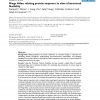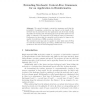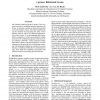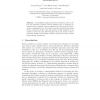282 search results - page 44 / 57 » On predicting secondary structure transition |
BMCBI
2007
13 years 7 months ago
2007
Background: Relating features of protein sequences to structural hinges is important for identifying domain boundaries, understanding structure-function relationships, and designi...
RECOMB
2005
Springer
14 years 7 months ago
2005
Springer
We present a novel computational method, MultiBind, for recognition of binding patterns common to a set of protein structures. It is the first method which performs a multiple alig...
LATA
2010
Springer
14 years 2 months ago
2010
Springer
We extend stochastic context-free grammars such that the probability of applying a production can depend on the length of the subword that is generated from the application and sho...
IJCAI
2007
13 years 9 months ago
2007
We introduce relational grams (r-grams). They upgrade n-grams for modeling relational sequences of atoms. As n-grams, r-grams are based on smoothed n-th order Markov chains. Smoot...
RECOMB
2006
Springer
14 years 7 months ago
2006
Springer
Abstract. A probabilistic graphical model is developed in order to detect the dependent evolution between different sites in biological sequences. Given a multiple sequence alignme...




